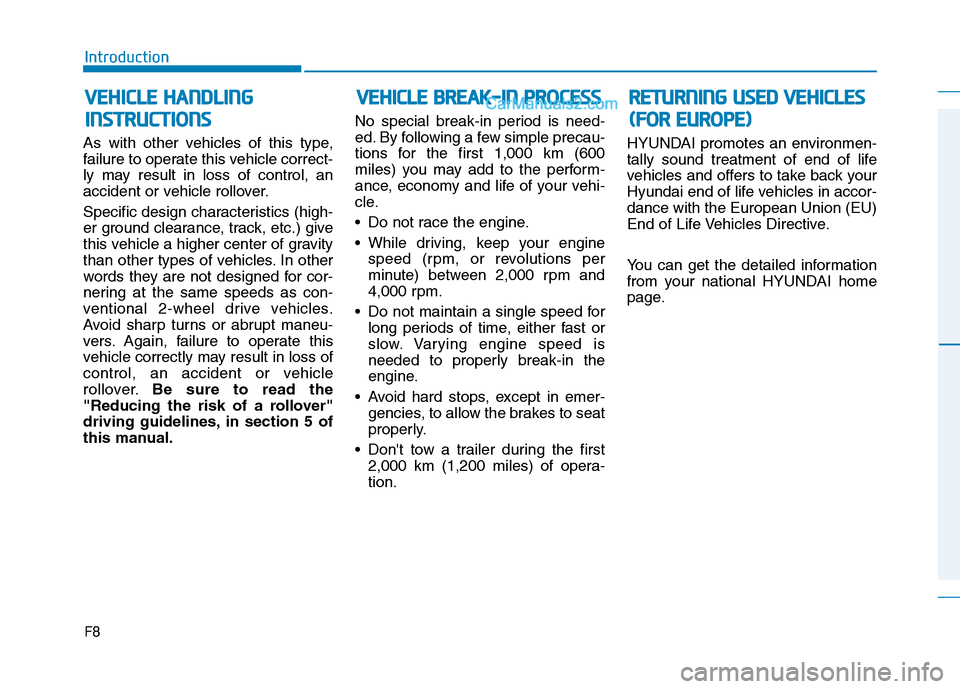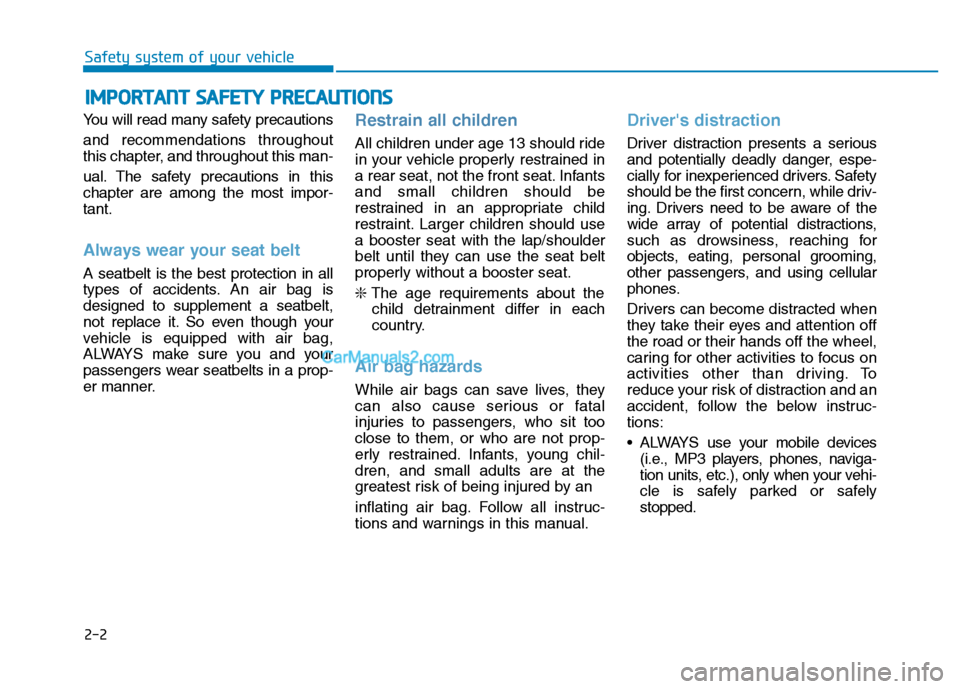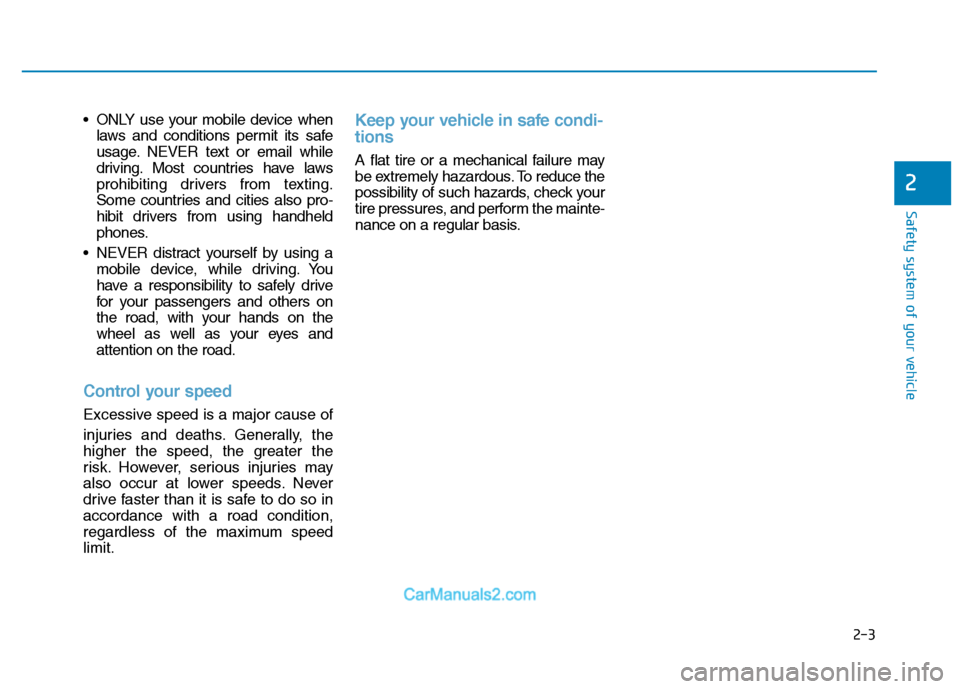2016 Hyundai H350 wheel
[x] Cancel search: wheelPage 8 of 473

F8
Introduction
As with other vehicles of this type,
failure to operate this vehicle correct-
ly may result in loss of control, an
accident or vehicle rollover.
Specific design characteristics (high-
er ground clearance, track, etc.) give
this vehicle a higher center of gravity
than other types of vehicles. In other
words they are not designed for cor-
nering at the same speeds as con-
ventional 2-wheel drive vehicles.
Avoid sharp turns or abrupt maneu-
vers. Again, failure to operate this
vehicle correctly may result in loss of
control, an accident or vehicle
rollover.Be sure to read the
"Reducing the risk of a rollover"
driving guidelines, in section 5 of
this manual. No special break-in period is need-
ed. By following a few simple precau-
tions for the first 1,000 km (600
miles) you may add to the perform-
ance, economy and life of your vehi-
cle.
Do not race the engine.
While driving, keep your engine
speed (rpm, or revolutions per
minute) between 2,000 rpm and
4,000 rpm.
Do not maintain a single speed for long periods of time, either fast or
slow. Varying engine speed is
needed to properly break-in the
engine.
Avoid hard stops, except in emer- gencies, to allow the brakes to seat
properly.
Don't tow a trailer during the first 2,000 km (1,200 miles) of opera-tion. HYUNDAI promotes an environmen-
tally sound treatment of end of life
vehicles and offers to take back your
Hyundai end of life vehicles in accor-dance with the European Union (EU)
End of Life Vehicles Directive.
You can get the detailed information
from your national HYUNDAI home
page.
VV
EEHH IICC LLEE HH AANN DDLLIINN GG
I
I NN SSTT RR UU CCTT IIOO NNSS V
V
EEHH IICC LLEE BB RREEAA KK--IINN PP RR OO CCEE SSSS RREETT UU RRNN IINN GG UU SSEE DD VV EEHH IICC LLEE SS
(
( FF OO RR EE UU RROO PPEE))
Page 11 of 473

1-2
Your vehicle at a glanceE
E XX TTEERR IIOO RR OO VVEERR VV IIEE WW (( II))
OEU014001The actual shape may differ from the illustration.
1. Front windshield wiper blades ...........7-34
2. Hood ..................................................3-30
3. Headlamp ..........................................7-68
4. Front fog light.....................................7-68
5. Towing hook .......................................6-19
6. Outside rearview mirror .....................3-41
7. Tires and wheels ...............................7-42
8. Front door ..........................................3-11
9. Mid sliding door .................................3-15
10. Urea solution filler lid .......................3-34
11. Electrical step ..................................3-17
12. Camera ............................................5-37
13. Side marker light .............................7-75
■
■
Front view (BUS)
Page 13 of 473

1-4
EEXX TTEERR IIOO RR OO VVEERR VV IIEE WW (( IIIIII))
Your vehicle at a glance
OEU014007The actual shape may differ from the illustration. 1. Front windshield wiper blades ...........7-34
2. Hood ..................................................3-30
3. Headlamp ..........................................7-68
4. Front fog light.....................................7-68
5. Towing hook .......................................6-19
6. Outside rearview mirror .....................3-41
7. Tires and wheels ...............................7-42
8. Front door ..........................................3-11
9. Mid sliding door .................................3-15
10. Camera ............................................5-37
11. Side marker light .............................7-75
■■
Front view (VAN)
Page 15 of 473

1-6
EEXX TTEERR IIOO RR OO VVEERR VV IIEE WW (( VV ))
Your vehicle at a glance
OEU014011The actual shape may differ from the illustration. 1. Front windshield wiper blades ...........7-34
2. Hood ..................................................3-30
3. Headlamp ..........................................7-68
4. Front fog light.....................................7-68
5. Towing hook .......................................6-19
6. Outside rearview mirror .....................3-41
7. Tires and wheels ...............................7-42
8. Front door ..........................................3-11
9. Antenna ...............................................4-2
10. Side marker light .............................7-75
11. Camera ............................................5-37
12. Urea soultion filler lid .......................3-34
■■
Front view (Truck)
Page 17 of 473

1-8
IINN TTEERR IIOO RR OO VVEERR VV IIEE WW (( LL EE FFTT SS IIDD EE))
Your vehicle at a glance
1. Light control switch ..................................3-96
2. Front/Rear fog light switch .....................3-100
3. Head lamp leveling device switch ..........3-101
4.Instrument cluster illumination adjusting
switch ........................................................3-44
5. ECO roll switch* .......................................5-40
6. VDC off switch* ........................................5-24
7. Instrument cluster ....................................3-43
8. Horn .........................................................3-38
9. Driver's air bag* .......................................2-30
10. Turn signals/Passing switch ...................3-99
11. Wiper/Washer switch ...........................3-102
12. Steering wheel audio controls* ................4-3
13. Auto cruise controls* ..............................5-31
14. Hands free controls* .......Refer to the audio system in chaper 4
15. MDP (Multi Display) controls* ....................... Refer to the audio system in chaper 4
16. Steering column tilt & telescopic lock* ...3-38
17. Audio .......................................................4-2
18. Climate control system* .......................3-110
19. Driver's seat warmer* .............................2-9
20. Front passenger's right hand seat warmer*....................................................2-9
21. Manual transmission lever .....................5-14
22. Passenger's air bag* ..............................2-30
23. Fuse box ................................................7-50
24. Steering wheel .......................................3-37
* : if equipped OEU014003
The actual shape may differ from the illustration.
Page 22 of 473

2-2
You will read many safety precautions and recommendations throughout
this chapter, and throughout this man-
ual. The safety precautions in this chapter are among the most impor-tant.
Always wear your seat belt
A seatbelt is the best protection in all
types of accidents. An air bag isdesigned to supplement a seatbelt,
not replace it. So even though your
vehicle is equipped with air bag,
ALWAYS make sure you and your
passengers wear seatbelts in a prop-
er manner.
Restrain all children
All children under age 13 should ride
in your vehicle properly restrained in
a rear seat, not the front seat. Infantsand small children should be
restrained in an appropriate child
restraint. Larger children should usea booster seat with the lap/shoulder
belt until they can use the seat belt
properly without a booster seat. ❇
The age requirements about the
child detrainment differ in each
country.
Air bag hazards
While air bags can save lives, they
can also cause serious or fatal
injuries to passengers, who sit tooclose to them, or who are not prop-
erly restrained. Infants, young chil-dren, and small adults are at the
greatest risk of being injured by an
inflating air bag. Follow all instruc-
tions and warnings in this manual.
Driver's distraction
Driver distraction presents a serious
and potentially deadly danger, espe-
cially for inexperienced drivers. Safety
should be the first concern, while driv-
ing. Drivers need to be aware of the
wide array of potential distractions,
such as drowsiness, reaching for
objects, eating, personal grooming,
other passengers, and using cellular
phones.
Drivers can become distracted when
they take their eyes and attention offthe road or their hands off the wheel,
caring for other activities to focus on
activities other than driving. To
reduce your risk of distraction and an
accident, follow the below instruc-tions:
• ALWAYS use your mobile devices (i.e., MP3 players, phones, naviga-
tion units, etc.), only when your vehi-
cle is safely parked or safelystopped.
IIMM PPOO RRTTAA NN TT SS AA FFEE TT YY PP RR EECCAA UU TTIIOO NNSS
Safety system of your vehicle
Page 23 of 473

2-3
Safety system of your vehicle
ONLY use your mobile device whenlaws and conditions permit its safe
usage. NEVER text or email while
driving. Most countries have laws
prohibiting drivers from texting.
Some countries and cities also pro-
hibit drivers from using handheld
phones.
NEVER distract yourself by using a mobile device, while driving. You
have a responsibility to safely drive
for your passengers and others on
the road, with your hands on the
wheel as well as your eyes andattention on the road.
Control your speed
Excessive speed is a major cause of
injuries and deaths. Generally, the
higher the speed, the greater the
risk. However, serious injuries may
also occur at lower speeds. Never
drive faster than it is safe to do so inaccordance with a road condition,
regardless of the maximum speedlimit.
Keep your vehicle in safe condi- tions
A flat tire or a mechanical failure may
be extremely hazardous. To reduce the
possibility of such hazards, check your
tire pressures, and perform the mainte-
nance on a regular basis.
2
Page 24 of 473

2-4
Safety system of your vehicleS
S EE AA TTSS
Safety precautions
Adjust your seat, so that you can sit in
a safe, comfortable position. It plays
an important role in protecting the
driver and passengers, together withthe seat belts and air bags in an acci-dent.
Air bag
You can take steps to reduce the risk
of being injured by an inflating air
bag. Sitting too close to an air bag
greatly increases the risk of injury, as
the event the air bag inflates. Move
your seat as far back as possible
from front air bags, while still main-
taining control of the vehicle.
Seat belts
Always fasten your seat belt before
starting the vehicle.
At all times, passengers should sit
upright and be properly restrained.
Infants and small children must be
restrained in an appropriate child
restraint system. Children who out-
grow a booster seat and adults must
fasten their seat belts.
Do not use a cushion thatreduces friction between the
seat and the passenger. The
passenger's hips may slide
under the lap portion of the seatbelt during an accident or a
sudden stop. Serious or fatal
internal injuries may resultbecause the seat belt cannot
properly operate.
WARNING
To reduce the risk of serious
injury or death from an inflating
air bag, take the following pre-cautions:
•Adjust the driver’s seat in the
rearmost position, while main-
taining the ability to fully con-
trol the vehicle.
Hold the steering wheel with
both hands at the 9 o’clock
and 3 o’clock positions to
minimize the risk of injuries to
your hands and arms.
NEVER place anything or any-
one on the air bags.
WARNING
Take the following precautions
to adjust your seat belt:
NEVER use one seat belt to fasten more than one occu-pant.
Always sit in an upright posi-
tion with the lap portion of the
seat belt snug and low acrossthe hips.
NEVER allow children or small infants to ride on a pas-
senger's laps.
(Continued)
WARNING